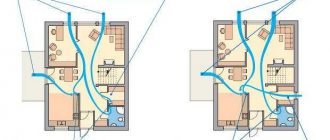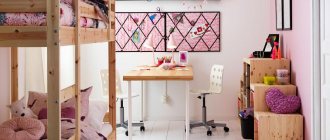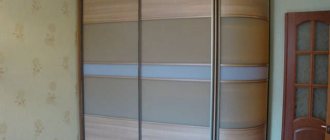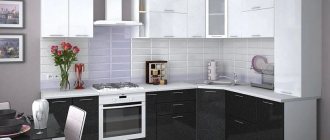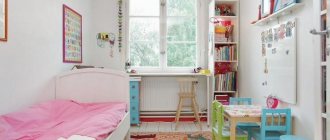SHARE ON SOCIAL NETWORKS
FacebookTwitterOkGoogle+PinterestVk
To ensure a rational and systematic approach to storing things in the house, it should have a dressing room: the layout with the dimensions of this room should ideally be taken into account at the design stage. If the area of the house has sufficient boundaries, it would be a good idea to place dressing rooms in it for each family member, including children. In the case where the apartment has modest dimensions, it can be one common, but carefully thought out room.
Dressing room equipped in the bedroom
Types of layout
The configuration of such premises can be completely different. When choosing existing types of dressing room layouts, you should proceed from the presence of openings (windows and doors) and the parameters of the room itself.
This will allow you to arrange the furniture most conveniently and use the space efficiently.
The most common dressing rooms:
- linear;
- parallel;
- U-shaped;
- corner
The linear type of dressing room layout is used in small areas. It gained its popularity due to its compactness and ease of installation. In this case, furniture elements are installed along the wall. A linear dressing room is equipped with pull-out shelves and hangers, which is facilitated by the free space in front of it.
There are similar designs:
- closed - with sliding or hinged doors;
- open - with free access to things stored there.
Parallel layout is also quite common: furniture is placed on opposite walls. The arrangement has a limitation: it is rational to place such a dressing room in a walk-through room. The advantages include ease of implementation, as well as functionality and spaciousness.
U-shaped planning is appropriate in small-sized rooms and in rooms with a large square footage.
This is the most spacious type of construction, since storage systems (drawers, shelves and hangers) are located along three walls in a “P” shape. For installation, you can use free walls with corners. Typically, U-shaped wardrobe furniture is a monolithic set that includes sections and cabinets with drawers, containers, shelves, and hangers.
For a dressing room located in a specialized room, for example, in a closet, an oblong shape of the room is preferable, which will simplify the installation of furniture.
The corner type of construction is installed mainly in rooms with a very limited area and allows rational use of their space.
A small dressing room is located in an empty corner in which it is impossible to place other furniture, for example, between window and door openings. Methods for installing interior items with a corner layout:
- All racks and shelves are placed strictly along one wall. In this case, the cabinets are left open. The free space in front of them can be used as a fitting room.
- Arranging furniture at an angle (along two walls) will allow you to place more clothes in it.
- You need to choose the type of layout depending on the square footage of the room. For spacious, roomy rooms, closed corner wardrobe designs with a plasterboard wall are used; for small areas, open ones are used.
How to arrange storage systems in a dressing room
Before installing furniture in the dressing room, the room needs to be prepared. First of all, it should be dry here, so you need to create ventilation. It is not recommended to create a storage room in a corner of the building that is prone to getting wet and not illuminated by sunlight. It is undesirable for it to have a common wall with the kitchen and bathroom. If there are no windows, then for ventilation you can install a fan that can turn on automatically after a certain period of time.
It is equally important that the dressing room is protected from the penetration of foreign odors. Bags filled with dry aromatic herbs will provide the room with a pleasant smell. And to protect things from insects, essential oils are used.
Storage systems can be purchased or made independently. In order for all things to be conveniently placed, you need to calculate the number and sizes of the required compartments. For example, for women it is important that the height of the hangers allows them to store their dresses, including long ones. Therefore, they must be at least 1.8 m. For storing men's jackets, 1.2 m will be enough. The size of the shelves should be within 30-35 cm. The depth of the cabinet may be affected by the width of the shoulders. Therefore, it is usually 50-70 cm.
The top of a closet is usually used to store blankets, pillows, bags and seasonal items. Umbrellas, gloves, hats and bags can be stored slightly above eye level. The middle part is occupied by shelves and hangers, under which drawers for linen are installed. The bottom tier will be occupied by shoes. It is most convenient to store it on rotating structures or on shelves, the angle of which is 45-60 degrees.
To make it easy to find the right thing here, the dressing room must have high-quality lighting. Lamps with warm or neutral light are ideal. LED spotlights mounted in the shelves would not be out of place here. Conventional lamps can be replaced with small spotlights that can be directed in any direction.
Examples of layout types in the photo
There are several basic types of dressing rooms, the layout and size of which depends on the placement of doors and windows, as well as the special preferences of the owners. Each type has characteristic features that make it suitable for a specific type of room.
Linear
Linear is similar to a regular wardrobe only without doors, without dividing into zones and without the usual furniture filling. This option is perfect for an elongated room along a blank wall. But you can also place it around a doorway.
Parallel
A parallel dressing room is the best option for elongated rooms and corridor-type rooms. Hangers and shelves are located along the free walls opposite each other. A window or large mirror is opposite the door. The presence of a window solves the problem of room ventilation and fills the room with daylight.
U-shaped
To create a U-shaped room, three walls are used, so this type of layout is considered the most convenient. This option is especially good when arranging large dressing rooms, where the central wall should be at least 1.5 meters in length. There is enough space for an ironing board, a mirror, and a chair.
Rods for clothes in two tiers, boxes, racks, shelves, drawers - everything can be placed here for storage.
L-shaped
One side of the L-shaped walk-in closet is the entrance. Adjacent walls form a corner, and the third side is the entrance. The fourth wall is optional. You can place furniture there: for example, shelving with closed back walls.
Corner
Cabinets with shelves and rods are installed along two adjacent walls. There can be a mirror or a vertical hanger in the corner. The third side is a screen or sliding doors, standard or semicircular (radius). Such a dressing room is good in a bedroom where the bed is positioned with the head of the bed facing the screen-partition.
This option is effective in rooms with limited space, since storage systems at an angle of 90° make it possible to store twice as many things as in a conventional linear cabinet.
Peculiarities
You can do a dressing room project yourself, but it’s easier to design the space using free programs. Various options are posted on the Internet, showing the interior space of a dressing room measuring 2 square meters. meters, tips from users have been published.
Features of organizing a dressing room on an area of 2 square meters. m.:
- First determine the length and width. The length of the hangers is 65 cm. This width of the room is needed to install the longitudinal rod. With a reduced format of the room, end hangers are allowed. In this case, the width of the dressing room can be 40 cm.
- The length of the dressing room is determined by the sum of the lengths of the cabinets and furniture that they plan to put there.
- Doors. They must be folding or compartment. Installation can be difficult, but a mirror can be conveniently hung on the sliding door - another space saver. If doors are expensive, they will be replaced by roller shutters, roller blinds, and blinds.
- Internal space should be used to the maximum. Use everything - walls, corners, ceilings. Hanging rods are fixed to the ceilings, where a net is installed, and boxes are hung. After removing the base of the cabinets, the craftsman will make a pull-out shelf for shoes.
- Hooks and hangers - there should be a lot of them. Fix the hooks on the wall, pull a chain onto the top hook - sections for hangers are ready.
- Horizontal bars on a retractable rod, installed in 5 cm increments - space for trousers. This way, your wardrobe items won’t get wrinkled, and even one 50 cm rod will be enough for a dozen pants.
- Hanging organizers are indispensable in a small dressing room of 2*2 m. You sew them yourself, equipping them with any number of pockets, and buy them ready-made.
You may be interested in: How to make a dressing room in the bedroom: in the form of a closet, corner and other interesting implementation options
And now the main thing is where to place the dressing room:
- in the pantry - there are already doors there, you can make a system of shelving with drawers, hangings, linear placement will be the most convenient;
- in the wardrobe - spacious structures are suitable for organizing the storage of all the necessary things; they are supplemented with shelves and boxes;
- in the hallway - convenient, but only on condition that its size is at least 4 square meters. m.
When choosing a layout, if the space is narrow and long, you should give preference to an L-shaped storage system. U-shaped is suitable for rooms with high walls.
Triangular, square-shaped dressing room with an area of 2 sq. m - option for niche openings in the bedroom, children's room or in intermediate passage spaces.
Principles of organization for men and women
Organizing any dressing room takes several steps.
- The first step is to think about the lighting so that you can easily admire your outfits in front of the mirror.
- The second step is to install ventilation in this room, especially if a washing machine is installed in it. But even if you are not going to wash in the wardrobe, then in order to avoid the appearance of an unpleasant odor in your clothes, an influx of fresh air is necessary.
- The third step is to determine the storage area. Its dimensions depend on the area of the dressing room itself and on the number of things that are planned to be stored there.
- The fourth step is to structure the space. At this stage, we plan the placement of sections, shelves where things will be stored, we decide on the basis in which this will be done (color, functionality, etc.).
When organizing a dressing room, you need to take into account that you need to leave the dressing room fully dressed. Only outerwear and street shoes are worn in the corridor.
A dressing room for women is a separate world. Here she can spend unlimited time trying on her clothes and sorting out accessories.
That is why, when equipping a wardrobe for a woman, you need to pay attention not only to functionality, but also to aesthetic beauty.
The classic women's option is a dressing room in pastel colors. Women often choose Provence or country styles to decorate these rooms.
- The latest fashion is to create a special place in the dressing room, in the center of which there is an ultra-fashionable sofa or, conversely, a vintage chest of drawers. Fill the room with various figurines and other designer little things.
- You definitely need a mirror, preferably a mobile one or even several, so that you can evaluate yourself in the chosen outfit from all sides.
- To equip a women's dressing room, you must remember to allocate space for storing bags and jewelry.
- A men's dressing room is a completely different matter. Brutality and functionality are the main directions in the equipment of this room for the stronger sex.
- Here you should choose restrained, calm colors. Brown, beige, gray tones, materials - metal or wood - are perfect.
- The style is more suitable hi-tech or classic. You need one mirror, full length.
- Men need to arrange an organizer for storing belts, and also equip a special hanger for ties.
- It is also worth setting aside a space where everything for hobbies will be collected. This is, for example, sportswear or camouflage for fishing. Immediately equip a place to store accessories (fishing rods, scooters).
- If you plan to combine a dressing room for a man and a woman, then usually the separation is done by color, while the female half is also tried to be kept a little in terms of brightness. Otherwise, they try to adhere to what was said above. The common part of the room is decorated neutrally.
You can choose any finishing materials for your dressing room, but it’s still better to choose washable ones. This is due to the fact that clothes and bedding tend to accumulate dust, which subsequently settles on the walls of the room.
For this reason, it is also better to avoid carpets on the floor. The most suitable flooring would be tile or laminate.
Accommodation options
If you definitely decide to organize a dressing room in your home, carefully consider its layout and decide on the size. But the most important decision, on which all subsequent actions on your part will depend, is the choice of the room where the dressing room should be created. Whether this will be a separate room, or whether it is worth separating part of one of the rooms for these purposes, is up to you to decide.
Assess the area of the home, the number and purpose of rooms in it. If there is a space of 4-8 square meters without windows, then creating a living room in it is not very reasonable. The lack of sunlight will affect the comfort level of such a room. But this quadrature is perfect for organizing a storage system for things, shoes, and accessories.
If there is no separate room, there is no need to be upset. You can separate part of the largest room in the apartment. For example, living room, bedroom, children's room. Even a corridor may be suitable for these purposes if its dimensions are so large that the space is not fully utilized. An excellent solution would be to use an existing niche or corner to install a storage system that should be planned. In other words, it is possible to arrange a dressing room in any room of any shape, if you approach the issue wisely.
Which doors to choose
Doors can be of any kind and from any material (wood, plastic, glass). But do not forget that the door should match the style of the adjacent room. The width of the doorway should be at least 60 cm.
Hinged doors require a lot of space, so they are often used in large walk-in closets. You can place hooks on the inside.
Sliding doors and accordion doors are used in shallow but wide dressing rooms. You can create a lighter option using fabric curtains or louvered doors.
Advantages and disadvantages of a small dressing room
A well-equipped mini dressing room has the following advantages:
- A specialized area for storing clothes and shoes is being formed.
- All things that are relevant for different seasons are in one place, and not placed in different cabinets, bedside tables and corners throughout the living space.
- More correct organization and getting used to order - suits hang on hangers, boots are on shelves, jackets are on hooks, etc.
- All items are in plain sight; when searching for them, there is no need to rummage through piles and piles - like in a cramped closet.
- Even a small corner dressing room allows you to fully use all the occupied space - from floor to ceiling.
- The interior of living rooms is freed from many disturbing elements - wardrobes, chests of drawers, ironing boards, etc.
However, a wardrobe, the size of which does not exceed 1.5-2 square meters, cannot but have some disadvantages:
- Large mirrors, chests of drawers, and furnishings do not fit.
- In a small house it is not always possible to devote even 2-3 m2? to a separate closed room.
- It will be necessary to carry out construction and installation work in an already equipped living space.
Recommendation! In order for a miniature dressing room to be convenient, efficient and practical, to equip it you need to select storage systems that are appropriate in size - cabinets, baskets, shelves, rods, stands.
Internal organization
A mini-wardrobe in a 2 by 1 meter hallway is an area in which there cannot be an empty corner or piece of wall. For the convenience of storing things, organize space with different systems:
- Metal frame products. These can be profile structures equipped with elements and fittings. Mesh, drawers/additional drawers, and chests of drawers are used as filling. The particular convenience of frame systems is the absence of partitions and side walls. The mesh suspension is fixed on the wall, shelves, vertical and horizontal rods, baskets, and cargo are attached.
- Modular wardrobes in a bedroom or hallway 2 meters wide have only one drawback - the dimensions must be determined in advance. The supporting structure cannot be altered, but such a system is more durable.
- Shelving. Multi-level designs are especially convenient in limited space, for example, in a hallway or closet. Placing shelves and hangers at different heights will help you hang and arrange a lot of things, while the room looks neat. An example of shelving in the photo in a dressing room measuring 2 square meters. m proves that a lot can be placed in a small area.
- the upper level starts from 2.5 m, hats, boxes, and clothes that are rarely used are stored here;
- the middle level - from 60 cm to 2 m from the floor - is suitable for storing everyday wardrobe;
- lower level - up to 60 cm from the floor - a place for storing shoes, drawers;
- if there is very little space, the lower tier is increased to a height of 1 m and a second system of shelves is created for shirts, trousers, etc. Tips from experienced placement experts:
You may be interested in: Features of a corner dressing room: photos and implementation nuances
Thinking through the design of a dressing room with an area of 2 square meters. m, the master must clarify all dimensions, measure the width and height of the walls. Accurate dimensions are required when purchasing ready-made systems and materials for doing the work yourself.
Location
There can be several options for the location of a small dressing room:
- Pantry.
- Part of a bedroom, living room, corridor or other room.
- Additional space when combining bathrooms.
- Niches.
- Dead ends.
- Loggias.
- Attic.
The easiest way is to create and arrange corner wardrobes of small sizes. There is no need to erect additional partitions here. In modern houses with a standard layout, there are often quite spacious corners located away from window and door openings.
Important nuances
When planning, designing, creating and arranging a mini-wardrobe, it is important to consider the following nuances:
- The composition of the equipment elements must be thought through at the project stage, otherwise the matter can be much more expensive.
- Light colors and good lighting, including spotlighting of important areas, will significantly increase the comfort of using the room.
- The minimum dimensions of a dressing room depend on the location of storage elements and the characteristics of their operation.
- An ottoman or folding chair installed inside will help provide additional comfort.
- Drawers with dividers allow you to conveniently store small items.
- To quickly find things, it is better to use photo stickers or signatures.
Recommendation! The minimum width of a dressing room with a passage is calculated as double the depth of the drawer plus 0.5 m. So, if the drawer is only 50 cm, then the shortest distance from wall to wall in the room should be 1.5 m.
Materials and prices
Below is the cost of manufacturing and installing a dressing room made of laminated chipboard 16 and 25 mm and edges with a thickness of 0.4 to 2 mm (prices at the beginning of 2022).
Plate 16 mm
- Edge 0.4 mm - price 37,000 rub.
- Edge 2.0 mm price 48,000 rub.
Plate 25 mm
- Edge 0.5 mm - price 41,000 rub.
- Edge 2.0 mm - price 52,000 rub.
There was a desire to use a 25 mm thick board, but since it was not available, the dressing room was made from white laminated chipboard 16 mm thick with a 0.4 mm edge.
How to make a wardrobe
Creating a wardrobe is for professionals. Both the comfort of use and the degree of safety of things will depend on the quality of workmanship. However, if you have enough experience, you can do it yourself. For example, a dressing room 1 5 by 2 m from a standard pantry is arranged according to the following algorithm:
- Clear the pantry of items.
- If necessary, carry out repairs - level and update surfaces.
- Provide lighting and ventilation.
- Install furniture.
- Install storage system elements.
- Load with things.
When installing racks, shelves and other storage structures, great attention should be paid to the reliability of their fasteners. After all, in the end, quite a lot of things can be located on them, which together will give a large load.
Important! The wardrobe on the plan must be depicted in as much detail as possible - indicating the geometry, dimensions, as well as the main elements of equipment, their parameters and location.
How to do it yourself?
As you already understand, you don’t have to build a dressing room from scratch; you can remake it from a cluttered closet, loggia or balcony. When equipping it, refuse cabinet furniture, which takes up a lot of space. Give preference to special modular designs that do not have extra walls, but have convenient mobile cabinets. You can place the bar in the center, and on the sides of it there are shelves, which can be partially equipped with drawers and wicker baskets.
Don't forget to leave a little space at the entrance so you can move around the dressing room without hindrance. Attach a large mirror to the door so that it does not take up precious space.
From plasterboard (chipboard or MDF boards)
With certain skills, installing a plasterboard structure is not difficult:
- Cut the profile into elements of the size you require using special scissors. You first need to take measurements and draw up a plan for the future structure.
- For work you will need a screwdriver and self-tapping screws. Install the floor profile, then install the wall and ceiling structures. Do everything as carefully as possible, otherwise you may ruin the wall covering.
- When the profile frame is ready, you need to make a two-layer sheathing of plasterboard, between the sheets of which insulation should be placed. You can also place electrical wiring in this space.
- Prime the finished walls, then start decorating them. The easiest and fastest way to decorate is to use wallpaper; you can use wood-look decorative panels, which look more impressive and status-worthy.
- Experts advise simply painting the walls, however, this requires careful puttying and sanding so that they are perfectly smooth.
- It is best to put tiles on the floor; if desired, you can use linoleum, carpet or parquet. The covering should be such that you feel comfortable standing on it with your bare feet. At the same time, it will require constant cleaning, and carpet, in this case, is not the best solution.
It is desirable that the decoration of the walls and floor coincide with the design of the room in which it is located.
At the end, all that remains is to install sliding doors and equip a dressing room inside.
Wardrobe shelving
A great example of a mini wardrobe that takes up little space. The frame and shelves for it need to be matched to the color of the walls so that they do not stand out against their background.
- First, a frame is made from profiles that are attached to the wall. The shelves themselves can be made of wood or dark laminate.
- It is better to make shelves for shoes mesh so that street dirt does not accumulate on them. They are attached to metal struts.
- Hanging rods are also attached to metal struts. It should be noted here that they are quite expensive, but if you are planning a budget construction, there is an opportunity to save. Just use pieces of rod that are at least 0.6 cm in diameter.
- If they have an unpresentable appearance, decorate them with special tubes designed for electrical insulation. Their diameter should be larger than the rod. To shrink the tube, it is heated with a hair dryer.
- For shelves, you can use regular inexpensive laminate, which can be extended by joining several boards together.
- The internal content of almost all dressing rooms will be the same. The lower area is used to store shoes and umbrellas. You can also install brackets on which you will hang your pants. The middle zone is reserved for rods and drawers, where all clothes are stored - shirts, dresses, jackets. Underwear is placed in special drawers with dividers. The upper zone is reserved for hats, bags and suitcases.
Arranging a dressing room is an interesting and exciting process, especially if you have a lot of clothes. You can bring your wildest ideas to life by building the dressing room of your dreams!
Making a dressing room layout yourself: tips
A schematic representation of the future design will help you act according to the plan
To prevent unnecessary things from appearing in your home, it is recommended to clearly draw up a plan for your future dressing room. This layout allows you to plan in advance where clothes will be stored, where shoes will be, and also how many shirts and dresses will fit in one section. There are several basic recommendations for drawing up a plan:
- It is better to depict the diagram to scale by drawing the plan on a sheet of paper using a ruler
- for a more visual example, you can cut out scaled parts from cardboard and put them together - this way you can understand the full picture of the future system
- during the layout, you should get a dressing room where drawers, shelves, rods, pull-out baskets will be placed, and the distances between shelves and other elements will be indicated
- for normal operation it is necessary to maintain the following distances: between shelves for clothes - from 30 cm, between shelves for shoes - from 20 cm, section for shirts - from 120 cm, section for trousers - from 140 cm, section for dresses - from 150 cm and section for outerwear – from 160 cm
- in the upper compartment there is a compartment for hats, as well as for items that are rarely used
- on the side, for convenience, it is necessary to make a small high space for the ironing board
- below it would be appropriate to organize an area for storing a vacuum cleaner
Planning your wardrobe layout in advance will help you avoid mistakes during assembly, and will also help you rationally fit all your clothes in the storage area.
Making a compost box with your own hands: description of the main technical points, recipes for preparing compost (50 Photos & Videos) + Reviews
Mistakes to Avoid
When planning and arranging a dressing room, attention is often not paid to the little things, which can later lead to a whole problem. Let's try to prevent this and learn from other people's mistakes.
The choice of content must be made at the time of planning, otherwise there may be a significant increase in the cost of your project.
- It is better to paint the walls of the dressing room with paint rather than paste them with wallpaper. This is due to the fact that wallpaper can become stained, scuffed, or lose its appearance due to changes in humidity and contact with clothing, and the paint can be washed at any time.
- Do not use dark colors in the decoration, otherwise the dressing room from its loud name will simply turn into a closet.
- It is good to think over the ventilation system, otherwise an unpleasant odor and, even worse, mold may appear in the room. As a result, things may get damaged.
- Do not use a design that is very different from the main premises of the home. You can play with color, but at the same time maintain the overall style.
- Poor lighting, especially in large dressing rooms where fitting rooms are equipped, will distort colors, which will cause discomfort in the future. Consider multi-level lighting, organizing lighting using additional lamps.
- Don’t forget about comfort, install an ottoman or, if the size does not allow, a folding chair so that you can sit down while putting on tights or shoes. Whatever your dressing room is, remember, the main thing is that you like it.
Preparing the premises
Before ordering furniture, it was necessary to prepare the former storage room for a dressing room.
Invite furniture makers for final measurements only after the renovation is completed! After plastering the walls, the internal dimensions of the room will change, and the furniture may simply not fit.
Photo before renovation
Ceiling height is 2.9 meters. It was decided not to touch the suspended ceiling and two installed spotlights
Subsequently, the burst wall will be plastered with reinforcing mesh
The wire for the spotlights comes out of the wall and goes under the suspended ceiling - cut it and hide it in the wall
There are joined pieces of linoleum on the floor - throw it out and lay a new one
They decided not to change the door to the dressing room.
Please immediately note that the door is not located in the center, but is significantly shifted to the left. The presence of a wide partition on the right side made it possible to subsequently produce shelves 500 mm wide (see exact dimensions below).
Wallpaper and glue
I wanted to renovate the space for a dressing room in such a way that I wouldn’t have to return to it for a long time.
Wallpaper requirements:
- Reliable - so as not to be fumbled with hangers, clothes and plastic containers.
- Light - to make it banally lighter.
- Washable - easy to wipe off if necessary.
- They do not require matching the pattern when gluing.
The choice fell on Belgian wallpaper Grandeco Life.
According to the information on the label, Grandeco Life wallpaper can be brushed!
The glue was used for non-woven wallpaper.
KLEO wallpaper adhesive for all types of non-woven wallpaper
Photo after renovation
They hid the wire above the door and laid commercial linoleum on the floor. I wanted to choose a different color and pattern, but I had to choose from what was available. After laying the linoleum, naturally, we installed a plinth (PVC)
Wallpaper texture Grandeco Life
Choosing a style
A dressing room is a place that should stylistically echo the room next to which it is located, for example, a bedroom.
- high-tech shelving and classic bedchamber furnishings will look ridiculous
- However, by playing around with the same racks and playing with the color of the finish, dissonance can be avoided.
- Minimalism, loft, hi-tech. These are racks with metal supports and the same or glass shelves.
- to the classics if the frame and shelves are made of wood. But glass shelves are also suitable.
- Dressing rooms have their own interior style - boiserie. This is when the shelves are attached not to the frame installed along the walls, but to the wall itself. Practical, since the room is not burdened by vertical racks.
But not every wall, especially plasterboard, will support the weight of the shelves along with the contents. Then you can supply special cabinet modules for dressing rooms, examples of which are in furniture catalogs.
Purpose dressing room
The bulky “walls” of the 90s have been replaced by elegant wardrobes. The habit of storing clothes and other wardrobe accessories in one place has created a new social demand: wardrobe areas.
A separate zone allows you to keep clothes, shoes and bedding in one place, without placing them among chests of drawers, cabinets and closets throughout the house.
A spacious dressing room will allow you to store all textile items in one place. Source pragmatika.media
The design of the dressing room is usually adjusted to the overall style of the room. Thus, in a room made in the Scandinavian style, a glass structure from the Art Nouveau style is unlikely to be appropriate, and a brick wall in the loft style will not harmonize with the elegant Art Deco monograms.
The design of the dressing room should not interfere with the overall style of the room. Source i.dobrzemieszkaj.pl
Modern dressing rooms amaze with their variety of design and layout. They act as separate enclosed areas in studio apartments and even as separate rooms from the bedroom in mansions. The main structure of the structure: supporting frame and equipment, ventilation holes and spot lighting.
Rows of shelving are the most ergonomic and functional furniture for such needs: thanks to it, it is possible to rationally use the space from floor to ceiling. The racks are easy to look at, there is no need to spend a long time sorting through things in chests of drawers and drawers.
Shelving in the dressing roomSource garderobnaya-msk.ru
A 21st century dressing room is not a luxury, but rather a necessity for those who value their time, especially in the morning hours, when searching for the right thing can delay or throw you off schedule. Everything here is designed for maximum order and convenience.
All shelves are visible - this speeds up the process of finding the right thing. Source goodhome.rf
Wall cabinets are usually held together with ties and look like one or a group of modules. There are systems that are a single load-bearing panel mounted along the wall in the middle of a studio apartment.
The frame system consists of metal posts to which all other elements are attached. The metal frame of the modular wardrobe ensures ease and reliability of assembly. The modular design can be expanded and altered as needed, and is easy to dismantle and transport.
The frame and contents of a custom-designed dressing room will cost significantly more than prefabricated modules, but they will fit well into the home interior.
The modular design can be reduced or expanded if necessary. Source www.praim-mebel.ru
Design and selection of furniture
The design of the dressing room must certainly be in harmony with the interior of the room it is adjacent to. For example, wooden shelves are best suited for a classic style, and plastic and metal for a modern high-tech style.
There are several tricks for placing such furniture in a small room:
- For a very small dressing room, you can adapt a niche in the wall, the passage to which is covered with curtains or sliding doors.
- If the room is very cramped, the dressing room should be left open, but with a large number of roll-out drawers, shelves, and hangers. An ottoman and a mirror will successfully complement such an interior.
- In a small bedroom, racks with casual clothes can be placed behind the headboard.
Furniture designs for dressing rooms are varied, but must be ergonomic and functional, these are:
- tall cabinets without doors;
- racks of different sizes that have a specific purpose: storing shoes, clothes or accessories;
- drawers for underwear or with crossbars for trousers;
- systems for storing raincoats, down jackets, coats, dresses, jackets;
- shelves for storing winter, summer and demi-season shoes;
- vertical spiral hangers for bags and clutches.
For small walk-in closets, modular furniture made of metal is suitable. Also, a mobile structure designed to accommodate various hangers will take up little space in the room. Shoes are placed under it, and hooks for bags are mounted on the sides.
Arranging a dressing room
In a small dressing room, ergonomics is important, so choosing furniture for it should be especially scrupulous.
The design can be stationary or rod (racks).
- Ceiling cabinets without doors are an ideal option.
- Racks with compartments of different heights and widths are also an excellent solution. The depth is selected taking into account the purpose of the department - for shoes or accessories, for folded items or for outerwear.
- Pull-out cabinets with a bottom for underwear or crossbars for scarves and trousers.
- Storage system for coats, blouses, jackets. It is estimated that a height of 0.5-0.7 meters is enough for short clothes on hangers. For outerwear and dresses you will need 1.5 m. Since we are using the entire height of the walls, it makes sense to place these two sections on top of each other.
- You will need shelves for bags (but they can also be hung on a vertical hanger, the hooks of which go in a spiral), crossbars or shelves for shoes, shelves for folded clothes (sweaters, T-shirts, bed linen, etc.), drawers for gloves.
It is worth leaving space for storing umbrellas and ironing boards. And put baskets on the free shelves.
Useful tips for arrangement
Not everyone has the opportunity to install huge storage facilities for things. Often you have to be content with more modest premises. But even in the smallest dressing room (1 x 1 m) you can create all the conditions so that every item has its place.
Some tips:
- the space of the room will look visually larger if you use glass or glossy doors and lighting built into the shelves;
- drawer dividers will allow you to store belts, ties, and jewelry in a systematic way;
- inscriptions on drawers and boxes with lids will help you find the necessary items faster;
- to avoid the appearance of musty odors and dampness, good ventilation must be provided;
- It is necessary to promptly get rid of things that have not been used for a long time, which will allow you not to create a mess in the room and free up space on the shelves.
It is recommended to design the optimal arrangement of boxes, containers and organizers made of plastic, fabric, straw or wood. They are ideal for storing belts, ties, scarves, gloves, and clothes that do not require ironing. In addition, such storage systems help save space on shelves and quickly find the things you need.
Dressing rooms design projects (photos)
Having carefully planned the compartments for the clothes of all family members, you can move on to dressing rooms, design projects and its components in the photo . They use rods. They are necessary for placing clothes in length. Having correctly assessed the height of your outfits, you need to calculate how many rods to install and at what height they will be. To save room space, pantographs are used. They release the bar to the required level. This way, dresses, trousers and long outerwear will be at an acceptable height and will not wrinkle.
They organize the drawers themselves and arrange them according to the type of laundry. In the future, this convenient item can also be used for accessories (belts, ties, scarves). A large number of dividers in a drawer will determine its functionality and help you place various items more conveniently.
Shelves and racks are great for keeping things organized, but they are expensive.
Ordinary baskets and boxes can replace cabinets for accessories. They are made to match the style of the entire dressing room and are used for clothes that are not related to the current season.
A special place is designed for shoes where they will not be subject to modifications or deformations. Special care and the creation of a separate module will allow you to preserve your shoes for many seasons. The convenient location of the mirror is also taken into account so that you can see yourself in full growth and in good lighting.




